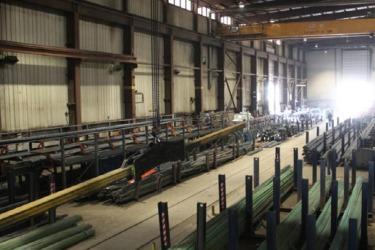What concrete offers in compressive strength, it lacks in ductility. Unsupported, it can bear fairly heavy loads without cracking, but if poured using rebar construction, concrete can take considerably more load, even when suspended.
Steel bars offer the best reinforcement properties for structural concrete than any other type of material. This is because steel possesses significant strength of its own. It can bend without breaking under stress. Additionally, its thermal coefficient — that is, its rate of expansion and contraction in heat or cold — is almost identical to that of concrete. Once embedded, steel and concrete will expand and contract together so that the concrete maintains cohesion. A reinforcement material with an unequal thermal coefficient would result in broken concrete rather quickly. The deformations — ridges or indentations — in the rebar limit movement of the bar along its axis within the concrete.
Five basic types of rebar have proven effective to increase the tensile strength of concrete. With differing properties, each type fulfills certain roles according to the architect or engineer’s specifications. Often, more than one of the five types of rebar will support a single structure.
CARBON STEEL
This most economically produced steel has a high carbon content which lends it a black hue. Carbon steel offers plenty of tensile support and works well when it will be completely encased in the slurry. Many concrete formulas feature high alkalinity, and when it comes in contact with the slightly rusted outer surface of carbon steel rods, a chemical reaction forms a coating that prevents the steel from corroding within its tomb of concrete.
STAINLESS STEEL
With less carbon and more chromium, nickel or manganese, stainless steel doesn’t corrode. Also, stainless steel is inherently stronger than its high-carbon cousin. However, the cost of stainless steel is about 30 percent higher than carbon steel, or black bar. Unless the load requirements demand all stainless steel rebar, generally, it is used for dowels across expansion joints, anywhere it will be exposed and when the concrete will be subjected to sustained heavy loads. Stainless steel, though more expensive, can actually prove the most economical rebar option for roads, bridges, piers, seawalls and other structures that will bear extreme loads and/or exposure to salt and salt products.
EPOXY-COATED CARBON STEEL
Where the concrete mix will not provide the high alkalinity necessary to protect black bar from corroding, the design may call for epoxy-coated carbon steel. This green coating still permits sufficient adhesion with the concrete while protecting it from rusting within the structure. Rust pushes out on the concrete, adding internal pressure that eventually weakens and decomposes the concrete. Epoxy coatings offer the most economical solution for low-alkaline concrete construction. The only difficulty with epoxy is its rather tender skin which can suffer damage if handled improperly.
GALVANIZED STEEL
Hot-dipped galvanized steel rebar takes black bar and applies a zinc coating which also prevents rusting. Rather than a barrier against the corrosive elements of the concrete or the chloride percolating through the pores, a zinc alloy acts as a sacrificial outer layer. The zinc slowly loses particles to the concrete over the years, preventing the steel from doing the same. While galvanized steel rebar offers long-term protection against rusting, as does epoxy coatings, it clings more tightly to the steel, which renders it less delicate when shipping, placing and welding.
